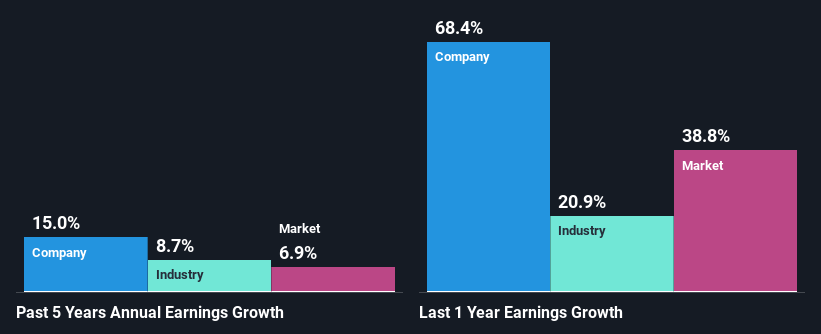Is Bloomsbury Publishing Plc's (LON:BMY) Latest Stock Performance Being Led By Its Strong Fundamentals?
Bloomsbury Publishing's (LON:BMY) stock is up by 4.7% over the past three months. Given that the market rewards strong financials in the long-term, we wonder if that is the case in this instance. In this article, we decided to focus on Bloomsbury Publishing's ROE.
Return on Equity or ROE is a test of how effectively a company is growing its value and managing investors’ money. In other words, it is a profitability ratio which measures the rate of return on the capital provided by the company's shareholders.
View our latest analysis for Bloomsbury Publishing
How To Calculate Return On Equity?
ROE can be calculated by using the formula:
Return on Equity = Net Profit (from continuing operations) ÷ Shareholders' Equity
So, based on the above formula, the ROE for Bloomsbury Publishing is:
12% = UK£20m ÷ UK£162m (Based on the trailing twelve months to August 2021).
The 'return' is the yearly profit. So, this means that for every £1 of its shareholder's investments, the company generates a profit of £0.12.
Why Is ROE Important For Earnings Growth?
Thus far, we have learned that ROE measures how efficiently a company is generating its profits. Based on how much of its profits the company chooses to reinvest or "retain", we are then able to evaluate a company's future ability to generate profits. Assuming everything else remains unchanged, the higher the ROE and profit retention, the higher the growth rate of a company compared to companies that don't necessarily bear these characteristics.
A Side By Side comparison of Bloomsbury Publishing's Earnings Growth And 12% ROE
At first glance, Bloomsbury Publishing seems to have a decent ROE. Further, the company's ROE compares quite favorably to the industry average of 8.6%. This certainly adds some context to Bloomsbury Publishing's decent 15% net income growth seen over the past five years.
As a next step, we compared Bloomsbury Publishing's net income growth with the industry, and pleasingly, we found that the growth seen by the company is higher than the average industry growth of 8.7%.
Earnings growth is a huge factor in stock valuation. What investors need to determine next is if the expected earnings growth, or the lack of it, is already built into the share price. By doing so, they will have an idea if the stock is headed into clear blue waters or if swampy waters await. Is BMY fairly valued? This infographic on the company's intrinsic value has everything you need to know.
Is Bloomsbury Publishing Using Its Retained Earnings Effectively?
With a three-year median payout ratio of 43% (implying that the company retains 57% of its profits), it seems that Bloomsbury Publishing is reinvesting efficiently in a way that it sees respectable amount growth in its earnings and pays a dividend that's well covered.
Moreover, Bloomsbury Publishing is determined to keep sharing its profits with shareholders which we infer from its long history of paying a dividend for at least ten years. Upon studying the latest analysts' consensus data, we found that the company is expected to keep paying out approximately 48% of its profits over the next three years. As a result, Bloomsbury Publishing's ROE is not expected to change by much either, which we inferred from the analyst estimate of 10.0% for future ROE.
Summary
On the whole, we feel that Bloomsbury Publishing's performance has been quite good. Particularly, we like that the company is reinvesting heavily into its business, and at a high rate of return. Unsurprisingly, this has led to an impressive earnings growth. That being so, according to the latest industry analyst forecasts, the company's earnings are expected to shrink in the future. Are these analysts expectations based on the broad expectations for the industry, or on the company's fundamentals? Click here to be taken to our analyst's forecasts page for the company.
Have feedback on this article? Concerned about the content? Get in touch with us directly. Alternatively, email editorial-team (at) simplywallst.com.
This article by Simply Wall St is general in nature. We provide commentary based on historical data and analyst forecasts only using an unbiased methodology and our articles are not intended to be financial advice. It does not constitute a recommendation to buy or sell any stock, and does not take account of your objectives, or your financial situation. We aim to bring you long-term focused analysis driven by fundamental data. Note that our analysis may not factor in the latest price-sensitive company announcements or qualitative material. Simply Wall St has no position in any stocks mentioned.

